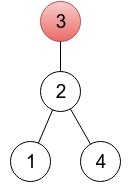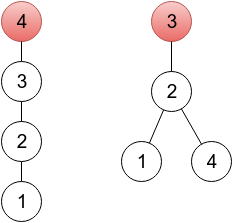CF698B.Fix a Tree
普及/提高-
通过率:0%
AC君温馨提醒
该题目为【codeforces】题库的题目,您提交的代码将被提交至codeforces进行远程评测,并由ACGO抓取测评结果后进行展示。由于远程测评的测评机由其他平台提供,我们无法保证该服务的稳定性,若提交后无反应,请等待一段时间后再进行重试。
题目描述
A tree is an undirected connected graph without cycles.
Let's consider a rooted undirected tree with n vertices, numbered 1 through n . There are many ways to represent such a tree. One way is to create an array with n integers p1,p2,...,pn , where pi denotes a parent of vertex i (here, for convenience a root is considered its own parent).

For this rooted tree the array p is [2,3,3,2] .Given a sequence p1,p2,...,pn , one is able to restore a tree:
- There must be exactly one index r that pr=r . A vertex r is a root of the tree.
- For all other n−1 vertices i , there is an edge between vertex i and vertex pi .
A sequence p1,p2,...,pn is called valid if the described procedure generates some (any) rooted tree. For example, for n=3 sequences (1,2,2), (2,3,1) and (2,1,3) are not valid.
You are given a sequence a1,a2,...,an , not necessarily valid. Your task is to change the minimum number of elements, in order to get a valid sequence. Print the minimum number of changes and an example of a valid sequence after that number of changes. If there are many valid sequences achievable in the minimum number of changes, print any of them.
输入格式
The first line of the input contains an integer n ( 2<=n<=200000 ) — the number of vertices in the tree.
The second line contains n integers a1,a2,...,an ( 1<=ai<=n ).
输出格式
In the first line print the minimum number of elements to change, in order to get a valid sequence.
In the second line, print any valid sequence possible to get from (a1,a2,...,an) in the minimum number of changes. If there are many such sequences, any of them will be accepted.
输入输出样例
输入#1
4 2 3 3 4
输出#1
1 2 3 4 4
输入#2
5 3 2 2 5 3
输出#2
0 3 2 2 5 3
输入#3
8 2 3 5 4 1 6 6 7
输出#3
2 2 3 7 8 1 6 6 7
说明/提示
In the first sample, it's enough to change one element. In the provided output, a sequence represents a tree rooted in a vertex 4 (because p4=4 ), which you can see on the left drawing below. One of other correct solutions would be a sequence 2 3 3 2, representing a tree rooted in vertex 3 (right drawing below). On both drawings, roots are painted red.
 In the second sample, the given sequence is already valid.
In the second sample, the given sequence is already valid.